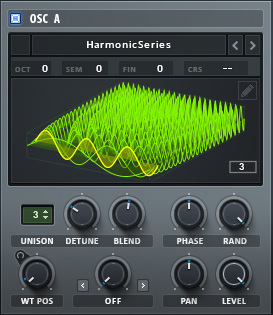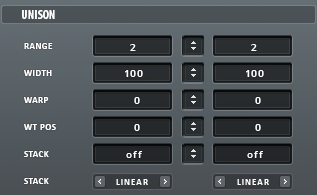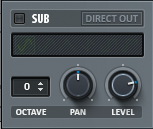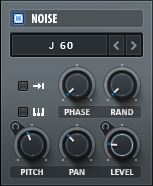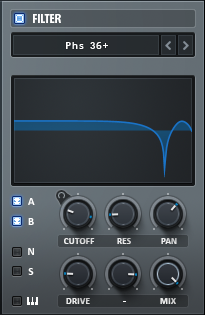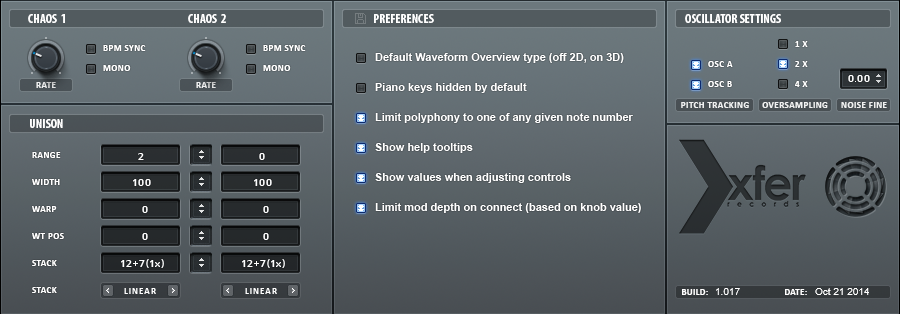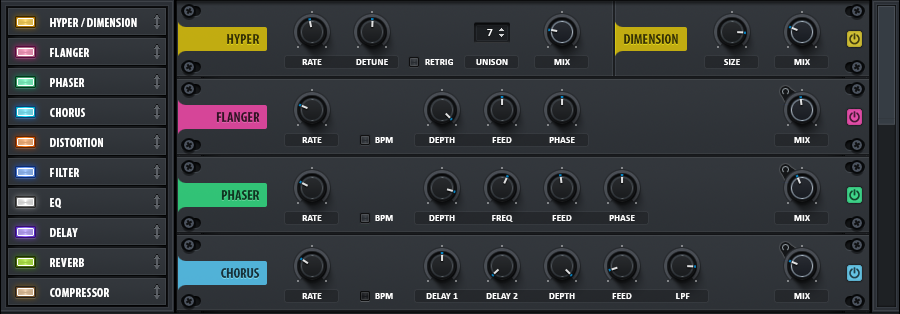Review: Serum


Serum from Xfer Records is a powerful wavetable synthesizer with a high quality sound and very easy to use interface. This is a great synthesizer for both beginners and expert sound designers as it is so easy to use yet have so many advanced features. All the main parameters are directly available on the front page with other parameters just a few mouse clicks away. This gives a good overview of your settings and makes it very easy to get started with Serum.
Presets
The 450+ factory presets are very nice sounding. The sound quality is excellent!
If you want more presets there is a lot of both commercial and free presets available for Serum.
However, I hope a future version of Serum will include a searchable preset browser as a supplement to the current preset menu.
Oscillators
Serum has four oscillators: Two powerful wavetable oscillators plus a sub oscillator and noice generator.
The two wavetable oscillators allow you to choose from 144 factory waveforms or you can import or edit your own waveforms. Click in the waveform view to toggle the display to show either a 3D rendering of the wavetable or a 2D rendering of the current waveform. By modulating the WT POS button you can create some nice evolving sounds that cycle through the wavetable.
The oscillators support unison with up to 16 voices. On the Global page there are several advanced unison settings for setting the amount of detune (Range), stereo width, warp, wavetable position and how to stack notes. This allow for some very rich sounds.
Tip: Ever wondered how your pictures sound? You can drag-and-drop a PNG picture into Serums waveform display to use it as a wavetable!
Wavetable synthesizers must do some resampling internally in order to play the same sample at different frequencies and this will normally result in some audible artefacts - but not in Serum! The sound is much brighter than I am used to hearing in soft synths. This high sound quality does however come at a cost as Serum can be a little CPU hungry.
The sub oscillator only support six basic waveforms and can be transposed up or down four octaves. It can be routed directly to the output (bypassing filter and effect sections) for creating some clean sub bass.
The noice generator can run in loop mode or one-shot, which is great for adding some percussive burst to the front of a sound. It contains several noice waveforms but also some drum kit sounds.
The oscillators support up to 16 voice unison, where each voice can have their own unique waveform.
Serum has a builtin wavetable editor so you are not limited to the factory wavetables but can import, create and modify your own wavetables.
Filters
Serum has more than 75 "filters" organized into four categories: Normal, Multi, Flanges and Misc. Actually it is a mix of traditional filters and effects e.g. Flangers, Phasers and Reverb.
The Normal filters include MG Low (which is a Ladder or Moog style filter), Low, and High pass filters in 6/12/18/24 db/octave variants. Also included are Band, Peak (like a EQ Bell filter) and Notch (Band Reject) filters in 12/24 db/octave.
The Multi filters combine two or three of the Normal filters e.g. the LP multi-filter is a combined Low-pass + Peak filter.
The Flanges and Misc filters include Comb, Flanger, Phaser, Ring modulator, Sample and Hold, French LP, German LP, Formant filters and more.
The oscillators can bypass the filter using the A/B/N/S buttons - the Sub-oscillator can also bypass both filter and FX using the DIRECT button.
Tip: Click the MIX label to turn the button into a LEVEL or gain control instead of wet/dry mix.
Notice there is a second filter in the Effect rack with the same filter options.
Modulation
Serum has combined the best of two worlds: You have a traditional 32-slot modulation matrix for a complete overview of all your modulations, but you can also use drag-and-drop to setup and adjust your modulations (similar to Massive). I am a big fan of drag-and drop modulation as this is so much easier than selecting mod sources and targets by diving into complex menus in a traditional modulation matrix.
As modulation source you can select from:
- 4 macro controls
- 3 AHDSR envelopes
- 4 LFO
- 2 Chaos (random) LFO's
You can edit the waveform of the LFO's and they can also be used for making complex multi-stage envelopes. Hold down the SHIFT button while drawing curves in the LFO view will turn the drawing tool into a stepper.
The two Chaos LFO's can be used to add some randomness to your modulations. Real useful! They are not located near the other LFO's, instead you have to switch to the Global page to edit the Chaos LFO's.
Effects
Some synthesizers do not have any builtin effects, others only support 1-2 effects. Serum sets the bar high with an impressive 10 slot effect rack on the FX tab! The effects include
- Compressor - which also can function as a Limiter
- Chorus
- Delay
- Dimension
- Distortion
- EQ
- Filter
- Flanger
- Hyper
- Phaser
- Reverb
You can enable/disable and reorder the effects in the effect rack to suit your needs.
Most of the effect parameters can be modulated e.g. dry/wet mix, amount of distortion etc.
CPU usage
When testing some complex sounds in Serum I noticed the CPU was working harder than usual with up to 35% CPU usage. When playing similar sounds in Massive I only noticed CPU usage up to 15%.
Disclaimer: The CPU usage was observed on a Windows 10 PC with an Intel Core i5 CPU and 16GB RAM. The tests was performed using Ableton Live (64 bit) with only a single active track with Serum loaded. Testing on other computers with a different OS or hardware may yield different results in actual CPU usuage.
Much to my surprise turning off all effects in the effect rack in Serum only resulted in slightly less CPU usage. I assume the high quality oscillators in Serum is the reason for this high CPU usage but it is a small price to pay for such high quality sound.
Verdict
Pros:
- Very intuitive user interface
- High quality oscillators with advanced unison
- Drag-and-drop modulation
- Builtin wavetable editor
- Powerful effects rack
- Chaos LFO's
Cons:
- No builtin arpeggiator/sequencer
- No preset browser
- A little demanding on the CPU
If your computer is old I would recommend you consider using Massive instead as it is less CPU demanding and can create more or less the same sounds as Serum. Serum is however one of the best sounding virtual instruments I have tried. Creating your own sounds is very easy and intuitive due to the well designed user interface.
Price
Serum is listed at $189. You can download a demo at Xfer Records (you need to register before you can download). The demo is limited to 15 minutes before it must be reloaded.

